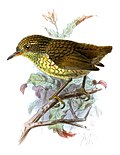| Ceratopipra | |
|---|---|
 | |
| Golden-headed manakin (male) (Ceratopipra erythrocephala) | |
| Scientific classification | |
| Kingdom: | Animalia |
| Phylum: | Chordata |
| Class: | Aves |
| Order: | Passeriformes |
| Family: | Pipridae |
| Genus: | Ceratopipra Bonaparte, 1854 |
| Type species | |
| Pipra cornuta von Spix, 1825 | |
| Species | |
5; see text | |
Ceratopipra is a genus of passerine birds in the family Pipridae.





